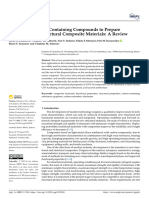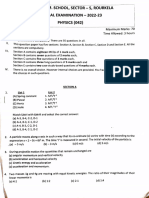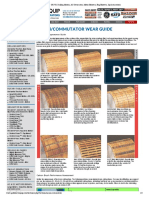Fabrication and Characterization of Aa6061/Cnts Surface Nanocomposite by Friction Stir Processing
Fabrication and Characterization of Aa6061/Cnts Surface Nanocomposite by Friction Stir Processing
Uploaded by
Ali RazaCopyright:
Available Formats
Fabrication and Characterization of Aa6061/Cnts Surface Nanocomposite by Friction Stir Processing
Fabrication and Characterization of Aa6061/Cnts Surface Nanocomposite by Friction Stir Processing
Uploaded by
Ali RazaOriginal Title
Copyright
Available Formats
Share this document
Did you find this document useful?
Is this content inappropriate?
Copyright:
Available Formats
Fabrication and Characterization of Aa6061/Cnts Surface Nanocomposite by Friction Stir Processing
Fabrication and Characterization of Aa6061/Cnts Surface Nanocomposite by Friction Stir Processing
Uploaded by
Ali RazaCopyright:
Available Formats
The International Journal of Advanced Manufacturing Technology
https://doi.org/10.1007/s00170-019-04243-7
ORIGINAL ARTICLE
Fabrication and characterization of AA6061/CNTs surface
nanocomposite by friction stir processing
Hussnain Riaz 1 & Tareq Mnazoor 2 & Ali Raza 3
Received: 12 March 2019 / Accepted: 31 July 2019
# Springer-Verlag London Ltd., part of Springer Nature 2019
Abstract
Aluminum matrix composites (AMCs) are among the advanced materials that are employed in numerous industrial applications.
AMCs have good stiffness and strength. They have low weight that makes them valuably handy for improving fuel efficiency and
economy in the structures made from them. The friction stir processing (FSP) is a novel technique which is highly advantageous
for producing composites, which are reinforced with particles that are sub-micron in size particularly in light weight metal matrix
composites (MMCs). Current study is done to examine the potential of AA6061-based surface nanocomposites by reinforcing it
with carbon nanotubes (CNTs) (as-received and purified) employing FSP. Fabrication of the composites is carried out by filling
CNTs into the grooves of different sizes and friction stir processed (FSPd). Various parameters are investigated to attain best
mechanical properties and dispersion of CNTs in the matrix. Metallography is used to reveal the material flow and grain size
variation in the zones formed by the FSP. Micro hardness and tensile tests are conducted to evaluate the mechanical properties and
an increase of 47.3% hardness and an increase of 32.4% ultimate tensile strength (UTS) are observed from the base FSPd
material. Electron microscopic techniques are also employed to reveal the microstructural details.
Keywords Aluminum matrix composites . Friction stir . CNTs . Tensile . Microstructure
1 Introduction technique that, in a single pass, improves the mechanical prop-
erties and microstructure of a material with less time and cost.
In loads of industrial applications, primarily in aerospace, au- In FSP, a revolving tool pin is sticked to the surface of a
tomotive, and railway industries, material selection with spe- material to be welded and crossed through its surface. Plastic
cific properties is of paramount importance. However, cost and friction distortion produced by tool is used to heat the
and time of production are the limiting factors to produce workpiece and make it soft. The local region is then modified
the alloys with specific properties like high strength. But, if by the rotating pin [3]. When reinforcement like CNTs is
we increase strength, ductility goes down. Hence, to flourish added in a groove or hole to form a composite, they are dis-
processing techniques by which high strength and high duc- persed uniformly in the stirred zone by the tool [4]. FSP offers
tility at the same time by keeping in check, the time of pro- many advantages over the conventional processes like the use
duction and cost are needed [1, 2]. FSP is a new processing of low-cost tool, robust finishing process requirement, utiliza-
tion of easily accessible machine tool technology, automation
suitability, energy efficiency, and environmental friendliness.
* Tareq Mnazoor The addition of CNTs into different matrices as a reinforce-
tareqmanzoor@cuilahore.edu.pk ment is getting a lot of interest in research community. In
addition to higher chemical and thermal stability, CNTs have
1
Dalian University of Technology, Dalian, China the capacity to exhibit high yield strength (YS) and elastic
2
COMSATS University Islamabad, Lahore Campus, Lahore, Pakistan
modulus values. CNTs have an ability to work as strengthen-
3
ing agents by the process of preventing atomic movements [3,
COMSATS University Islamabad, Sahiwal campus,
Sahiwal, Pakistan
5–10]. Thus, CNTs have great potential as reinforcement in
You might also like
- Theory of Flow Fracture NadaiDocument611 pagesTheory of Flow Fracture Nadaimarc53042100% (2)
- 506 NCE Escalator QRDocument4 pages506 NCE Escalator QRwaclaw jazombekNo ratings yet
- Moment Connection DETAIL 2Document8 pagesMoment Connection DETAIL 2amachmouchiNo ratings yet
- Honda XR250 R XR 250 Owners Maintenance ManualDocument88 pagesHonda XR250 R XR 250 Owners Maintenance Manualcrawdoogie100% (3)
- FRP Hdpe ComparisonDocument3 pagesFRP Hdpe ComparisonbcsmurthyNo ratings yet
- Fabrication and Characterization of Aa6061/Cnts Surface Nanocomposite by Friction Stir ProcessingDocument21 pagesFabrication and Characterization of Aa6061/Cnts Surface Nanocomposite by Friction Stir ProcessingAli RazaNo ratings yet
- A Review On NSM-CFRP Technique Using in Shear Strengthening of RC Deep BeamsDocument18 pagesA Review On NSM-CFRP Technique Using in Shear Strengthening of RC Deep Beamsbassem kooliNo ratings yet
- Fibrous Composites ResearchDocument13 pagesFibrous Composites ResearchMostafa AliNo ratings yet
- Pristine and Amino Functionalized Carbon Nanotubes Reinforced Glass Fiber Epoxy Composites.Document31 pagesPristine and Amino Functionalized Carbon Nanotubes Reinforced Glass Fiber Epoxy Composites.venkatesh maduthuriNo ratings yet
- Evaluation of Mechanical Properties of Al-Tic Composites Reinforced With Carbon Nano TubesDocument4 pagesEvaluation of Mechanical Properties of Al-Tic Composites Reinforced With Carbon Nano TubesKalai ArasanNo ratings yet
- Advanced Composite Materials For Aerospace Applications (WWW - Kiu.ac - Ug)Document4 pagesAdvanced Composite Materials For Aerospace Applications (WWW - Kiu.ac - Ug)publication1No ratings yet
- Research ProposalDocument6 pagesResearch ProposalAbdalla Mohamed Abdalla100% (4)
- Design and Evaluation of 3D Printed Polymeric Cellular Materials For Dynamic Energy AbsorptionDocument15 pagesDesign and Evaluation of 3D Printed Polymeric Cellular Materials For Dynamic Energy AbsorptionHimprakash DasNo ratings yet
- Utilisation of Ultra-High Performance Fiber ReinfoDocument9 pagesUtilisation of Ultra-High Performance Fiber ReinfoSoham RotheNo ratings yet
- Analysis of Mechanical Characteristics of Aluminium Nano Composites Using MWCNTDocument8 pagesAnalysis of Mechanical Characteristics of Aluminium Nano Composites Using MWCNTsomumechNo ratings yet
- Evaluation of Aluminum-Coconut Shell Ash (CSA) Composite Using The TOPSIS MethodDocument9 pagesEvaluation of Aluminum-Coconut Shell Ash (CSA) Composite Using The TOPSIS MethodInternational Journal of Innovative Science and Research TechnologyNo ratings yet
- Ebsd Paper 3Document15 pagesEbsd Paper 3RamanvlrNo ratings yet
- Applsci 12 09945 v3Document23 pagesApplsci 12 09945 v3amuthakarNo ratings yet
- Electrical Thermal and Mechanical Properties of CNDocument20 pagesElectrical Thermal and Mechanical Properties of CNkhanhnd.hwNo ratings yet
- 1 s2.0 S0266353805001193 MainDocument14 pages1 s2.0 S0266353805001193 MainDevan1984No ratings yet
- Experimental Study of Quasi Static Loading For Hybrid Composite MaterialsDocument34 pagesExperimental Study of Quasi Static Loading For Hybrid Composite MaterialsAbdallah AL-ObideNo ratings yet
- Future Applications of Carbon NanotubesDocument7 pagesFuture Applications of Carbon Nanotubeshari.mdgift.4No ratings yet
- Reinforcement (Composite Materials)Document21 pagesReinforcement (Composite Materials)RanjithR ShettyNo ratings yet
- Njuguna Adv Poly 2 2003Document48 pagesNjuguna Adv Poly 2 2003Artemia Loayza ArguellesNo ratings yet
- Rapid Microwave Sintering of Carbon Nanotube-Filled AZ61Document8 pagesRapid Microwave Sintering of Carbon Nanotube-Filled AZ61vitorassuenaNo ratings yet
- Zhang 2021Document14 pagesZhang 2021Rob GNNo ratings yet
- Effect Of Α‑Al And Si Precipitates On Microstructural Evaluation And Corrosion Behavior Of Laser Powder Bed Fusion Printed Alsi10Mg Plates In Seawater EnvironmentDocument18 pagesEffect Of Α‑Al And Si Precipitates On Microstructural Evaluation And Corrosion Behavior Of Laser Powder Bed Fusion Printed Alsi10Mg Plates In Seawater Environmentsai charanNo ratings yet
- UduppaDocument6 pagesUduppaKoushik RaoNo ratings yet
- Er 5876Document28 pagesEr 5876indaabdul08No ratings yet
- Composites Part B: D.A. Pohoryles, D.A. BournasDocument10 pagesComposites Part B: D.A. Pohoryles, D.A. BournasTesfayeNo ratings yet
- A Review On Recent Development in Advanced Composite Marine PropellersDocument12 pagesA Review On Recent Development in Advanced Composite Marine PropellersIJRASETPublicationsNo ratings yet
- Allumalla ManojDocument6 pagesAllumalla ManojJaliJaNo ratings yet
- Mechanical Behavior of Porous Functionally Graded Nanocomposite MaterialsDocument21 pagesMechanical Behavior of Porous Functionally Graded Nanocomposite Materialsmuzakir sparkolNo ratings yet
- Development and Mechanical Characterization of Cenosphere Reinforced CFRP and Natural Rubber Core Sandwich CompositeDocument11 pagesDevelopment and Mechanical Characterization of Cenosphere Reinforced CFRP and Natural Rubber Core Sandwich CompositeVinyas MaheshNo ratings yet
- (2021) Interface Mechanics in Carbon Nanomaterials-Based NanocompositesDocument34 pages(2021) Interface Mechanics in Carbon Nanomaterials-Based NanocompositestloutasNo ratings yet
- Flexural Behavior of Composite Reinforced Concrete Slurry-Infiltrated Mat Concrete (SIMCON) MembersDocument10 pagesFlexural Behavior of Composite Reinforced Concrete Slurry-Infiltrated Mat Concrete (SIMCON) MemberspicottNo ratings yet
- Materials Science & Engineering ADocument11 pagesMaterials Science & Engineering AsrinikeshnakkinaNo ratings yet
- Vibration DelaminationDocument11 pagesVibration DelaminationCPA IMNo ratings yet
- 1 s2.0 S2238785419319714 MainDocument18 pages1 s2.0 S2238785419319714 MainRio ArrayNo ratings yet
- 1 AMSA10082 4 2pp.33 41 PDFDocument10 pages1 AMSA10082 4 2pp.33 41 PDFGyanesh PatnaikNo ratings yet
- Bakamal 2021Document14 pagesBakamal 2021Alireza Alidoust.LNo ratings yet
- Filament-Wound Glass-Fibre Reinforced Polymer CompDocument28 pagesFilament-Wound Glass-Fibre Reinforced Polymer CompDoua AbdouNo ratings yet
- Just 2Document7 pagesJust 2Gustavo Onzi CaberlonNo ratings yet
- Chapter 5Document31 pagesChapter 5Anirban ChangdarNo ratings yet
- 1 PBDocument11 pages1 PBأبو الحارث أمجد عثمانNo ratings yet
- 1 AMSA10082 4 2pp.33 41Document10 pages1 AMSA10082 4 2pp.33 41skyrunner3217No ratings yet
- Acta Metallurgica - Effect of Sintering Temperature and Heating Rate On Crystallite SizeDocument12 pagesActa Metallurgica - Effect of Sintering Temperature and Heating Rate On Crystallite SizeLavish Kumar SinghNo ratings yet
- Mmercz,+Production+Editor,+PPCI 11651 ofDocument10 pagesMmercz,+Production+Editor,+PPCI 11651 ofSUNAEKNo ratings yet
- Shao 2019Document13 pagesShao 2019Venkatesh PandianNo ratings yet
- 1997 - MACHININGOFFIBERREINFORCEDCOMPOSITES (Retrieved 2014 05 01)Document40 pages1997 - MACHININGOFFIBERREINFORCEDCOMPOSITES (Retrieved 2014 05 01)Ihab El SawiNo ratings yet
- A Systematic Study On Composite Materials in Civil EngineeringDocument18 pagesA Systematic Study On Composite Materials in Civil EngineeringOvijith GoswamiNo ratings yet
- Behavior of Strengthened RC Beams UsingDocument12 pagesBehavior of Strengthened RC Beams UsingmayasNo ratings yet
- Al6063 Stir Casting Wire Edm Grey Relation AnalysysDocument16 pagesAl6063 Stir Casting Wire Edm Grey Relation Analysysvijaypalika076No ratings yet
- 172 Ijmperdjun2019172Document8 pages172 Ijmperdjun2019172TJPRC PublicationsNo ratings yet
- Materials 16 02552Document28 pagesMaterials 16 02552Rijo SimonNo ratings yet
- Technical Note On Using CNTs As ReinforcementsDocument7 pagesTechnical Note On Using CNTs As Reinforcementsrameshbabu_1979No ratings yet
- 1 s2.0 S0950061822018438 MainDocument14 pages1 s2.0 S0950061822018438 MainJosé C. Ames EliasNo ratings yet
- Mrs 2015 231Document8 pagesMrs 2015 231MURAT METEHAN TÜRKOĞLUNo ratings yet
- Polymers 14 04595 v2Document19 pagesPolymers 14 04595 v2vi.petrescu2604No ratings yet
- Sma 3Document11 pagesSma 3RAJU T NNo ratings yet
- MalekzadehDocument19 pagesMalekzadehmfoyouzatNo ratings yet
- Metal Matri̇x Composi̇tes İntroDocument9 pagesMetal Matri̇x Composi̇tes İntroMustafa Mansur SalehNo ratings yet
- Self-healing Ceramic Matrix Composites: A MonographFrom EverandSelf-healing Ceramic Matrix Composites: A MonographNo ratings yet
- Energy, Work, Power and Momentum ReviewDocument7 pagesEnergy, Work, Power and Momentum ReviewJACOB SANCHEZNo ratings yet
- Physics Class 11Document9 pagesPhysics Class 11eagleankush5No ratings yet
- HMT Senthil CompressDocument515 pagesHMT Senthil Compresssathiyapriyan2003No ratings yet
- Manish Kumar Jadaun: Personal Info Current Work ProfileDocument1 pageManish Kumar Jadaun: Personal Info Current Work ProfileEr Manish JadaunNo ratings yet
- Brush Wear GuideDocument3 pagesBrush Wear GuideSomkene MbakweNo ratings yet
- 2.heat-Exchangers From Ch6 - Mihir's HandbookDocument12 pages2.heat-Exchangers From Ch6 - Mihir's HandbookThế Quang LêNo ratings yet
- Structural Steel Solution: Beams - Columns - Angles - ChannelsDocument24 pagesStructural Steel Solution: Beams - Columns - Angles - ChannelsPradeepNo ratings yet
- Universal Machining CentersDocument4 pagesUniversal Machining CentersAdhiraj SinghNo ratings yet
- TRF InspectionDocument15 pagesTRF InspectionSonny RaymundoNo ratings yet
- OLGA 2014 Particle (Sand) Transport Modeling and SimulationDocument14 pagesOLGA 2014 Particle (Sand) Transport Modeling and SimulationAkin MuhammadNo ratings yet
- Variable Displacement Axial Piston Pump Type V80M: Product DocumentationDocument22 pagesVariable Displacement Axial Piston Pump Type V80M: Product DocumentationY.EbadiNo ratings yet
- Manual For Temperature Control PDFDocument4 pagesManual For Temperature Control PDFReeve Tang CsvNo ratings yet
- PDF Belt Conveyor - CompressDocument11 pagesPDF Belt Conveyor - CompressNoviendo Tria AriwibowoNo ratings yet
- How To Draw Force DiagramsDocument3 pagesHow To Draw Force Diagramsapi-262120176100% (1)
- Performance Data: Paver (Tier 3) BF 700 C-2Document4 pagesPerformance Data: Paver (Tier 3) BF 700 C-2Leo Zuni CcamaNo ratings yet
- The Concept of Tube ExpandingDocument2 pagesThe Concept of Tube ExpandingbamarppNo ratings yet
- Storage Tank Test & Inspection Report enDocument10 pagesStorage Tank Test & Inspection Report enMarketing CTNNo ratings yet
- Various Loads Acting On High Rise BuildingsDocument14 pagesVarious Loads Acting On High Rise BuildingsSameer ShaikhNo ratings yet
- Dwyer Photohelic 3000mr - IomDocument2 pagesDwyer Photohelic 3000mr - Iomburtman2010No ratings yet
- 63b - Improving The Geometric Accuracy & Dimensional Tolerances of Printed Part in Cold Metal Transfer Robotic Welding SystemDocument12 pages63b - Improving The Geometric Accuracy & Dimensional Tolerances of Printed Part in Cold Metal Transfer Robotic Welding SystemAvyansh KatiyarNo ratings yet
- NCR Departmental Exam Carriage and Wagon Objective Question Bank PDFDocument23 pagesNCR Departmental Exam Carriage and Wagon Objective Question Bank PDFPravinNo ratings yet
- Falling Film Heat Transfer CoefficientDocument22 pagesFalling Film Heat Transfer CoefficientZarra FaktNo ratings yet
- Analysis of Axisymmetrical Shells by The Direct Stiffness MethodDocument6 pagesAnalysis of Axisymmetrical Shells by The Direct Stiffness MethodsaintshrimpNo ratings yet
- Unit and Dimension Speed Practice Sheet Yakeen NEET 2024Document4 pagesUnit and Dimension Speed Practice Sheet Yakeen NEET 2024factfusion7781No ratings yet
























































































